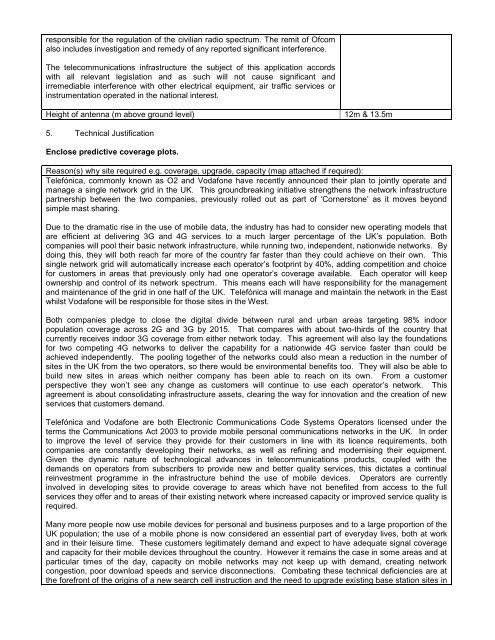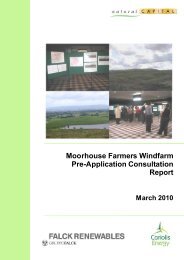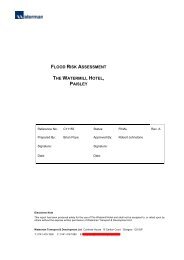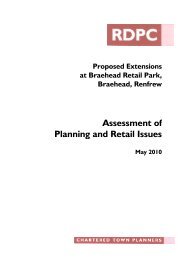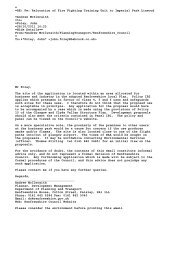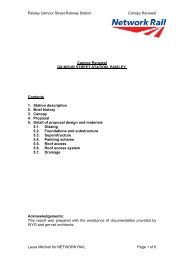Supporting documents - Renfrewshire Council
Supporting documents - Renfrewshire Council
Supporting documents - Renfrewshire Council
Create successful ePaper yourself
Turn your PDF publications into a flip-book with our unique Google optimized e-Paper software.
esponsible for the regulation of the civilian radio spectrum. The remit of Ofcom<br />
also includes investigation and remedy of any reported significant interference.<br />
The telecommunications infrastructure the subject of this application accords<br />
with all relevant legislation and as such will not cause significant and<br />
irremediable interference with other electrical equipment, air traffic services or<br />
instrumentation operated in the national interest.<br />
Height of antenna (m above ground level) 12m & 13.5m<br />
5. Technical Justification<br />
Enclose predictive coverage plots.<br />
Reason(s) why site required e.g. coverage, upgrade, capacity (map attached if required):<br />
Telefónica, commonly known as O2 and Vodafone have recently announced their plan to jointly operate and<br />
manage a single network grid in the UK. This groundbreaking initiative strengthens the network infrastructure<br />
partnership between the two companies, previously rolled out as part of ‘Cornerstone’ as it moves beyond<br />
simple mast sharing.<br />
Due to the dramatic rise in the use of mobile data, the industry has had to consider new operating models that<br />
are efficient at delivering 3G and 4G services to a much larger percentage of the UK’s population. Both<br />
companies will pool their basic network infrastructure, while running two, independent, nationwide networks. By<br />
doing this, they will both reach far more of the country far faster than they could achieve on their own. This<br />
single network grid will automatically increase each operator’s footprint by 40%, adding competition and choice<br />
for customers in areas that previously only had one operator’s coverage available. Each operator will keep<br />
ownership and control of its network spectrum. This means each will have responsibility for the management<br />
and maintenance of the grid in one half of the UK. Telefónica will manage and maintain the network in the East<br />
whilst Vodafone will be responsible for those sites in the West.<br />
Both companies pledge to close the digital divide between rural and urban areas targeting 98% indoor<br />
population coverage across 2G and 3G by 2015. That compares with about two-thirds of the country that<br />
currently receives indoor 3G coverage from either network today. This agreement will also lay the foundations<br />
for two competing 4G networks to deliver the capability for a nationwide 4G service faster than could be<br />
achieved independently. The pooling together of the networks could also mean a reduction in the number of<br />
sites in the UK from the two operators, so there would be environmental benefits too. They will also be able to<br />
build new sites in areas which neither company has been able to reach on its own. From a customer<br />
perspective they won’t see any change as customers will continue to use each operator’s network. This<br />
agreement is about consolidating infrastructure assets, clearing the way for innovation and the creation of new<br />
services that customers demand.<br />
Telefónica and Vodafone are both Electronic Communications Code Systems Operators licensed under the<br />
terms the Communications Act 2003 to provide mobile personal communications networks in the UK. In order<br />
to improve the level of service they provide for their customers in line with its licence requirements, both<br />
companies are constantly developing their networks, as well as refining and modernising their equipment.<br />
Given the dynamic nature of technological advances in telecommunications products, coupled with the<br />
demands on operators from subscribers to provide new and better quality services, this dictates a continual<br />
reinvestment programme in the infrastructure behind the use of mobile devices. Operators are currently<br />
involved in developing sites to provide coverage to areas which have not benefited from access to the full<br />
services they offer and to areas of their existing network where increased capacity or improved service quality is<br />
required.<br />
Many more people now use mobile devices for personal and business purposes and to a large proportion of the<br />
UK population; the use of a mobile phone is now considered an essential part of everyday lives, both at work<br />
and in their leisure time. These customers legitimately demand and expect to have adequate signal coverage<br />
and capacity for their mobile devices throughout the country. However it remains the case in some areas and at<br />
particular times of the day, capacity on mobile networks may not keep up with demand, creating network<br />
congestion, poor download speeds and service disconnections. Combating these technical deficiencies are at<br />
the forefront of the origins of a new search cell instruction and the need to upgrade existing base station sites in


